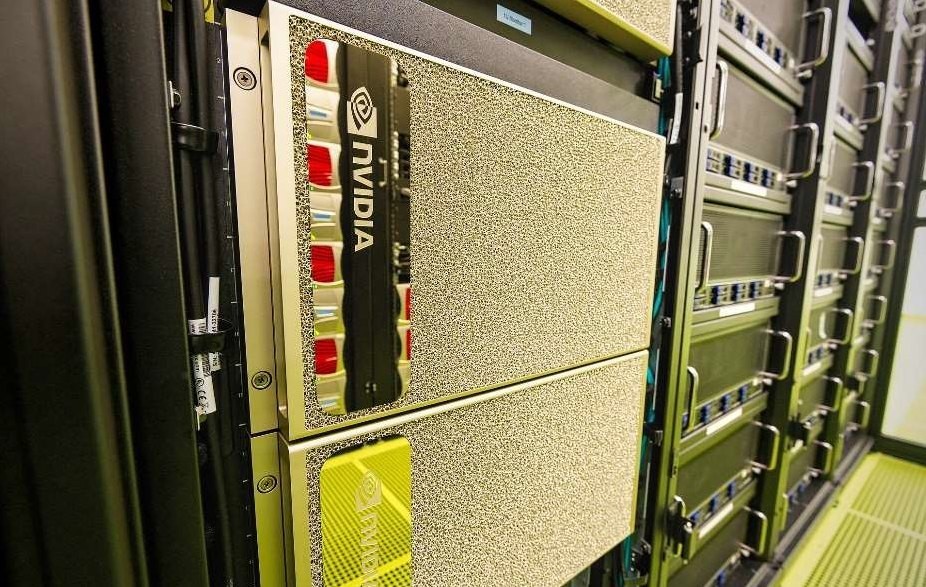 The new DGX A100 computer systems are high-performance servers, each with eight NVIDIA A100 Tensor Core GPUs. Together, the eight accelerators provide a computing power of 5 AI-PetaFLOP/s, i.e. five quadrillion computing operations per second. (Photo: Simon Raffeiner/SCC)
The new DGX A100 computer systems are high-performance servers, each with eight NVIDIA A100 Tensor Core GPUs. Together, the eight accelerators provide a computing power of 5 AI-PetaFLOP/s, i.e. five quadrillion computing operations per second. (Photo: Simon Raffeiner/SCC)
Artificial intelligence (AI) is indispensable today as a tool for cutting-edge research. In addition to algorithms, specialized hardware is becoming an increasingly important factor for its successful application - whether in energy research or in the development of new materials. The Karlsruhe Institute of Technology (KIT) has now become the first location in Europe to put the new NVIDIA DGX A100 AI system into operation. It was purchased with funds from the Helmholtz Artificial Intelligence Cooperation Unit (HAICU).
Whether in the development of autonomous robot systems or novel functional materials, whether in the optimization of energy systems or in the improvement of climate models: Artificial intelligence (AI) and machine learning (ML) are now an important part of research at KIT. In order to further advance the use of these future technologies, KIT is involved in the Helmholtz Artificial Intelligence Cooperation Unit (HAICU), a research-oriented platform of the Helmholtz Association for Applied AI, which promotes cross-field research projects. The aim is to identify and exploit similarities between applications and drive forward the development of new methods. "This requires one thing above all - extremely high computing power," says Martin Frank, Director at the Steinbuch Center for Computing (SCC) at KIT and Professor at the Institute for Applied and Numerical Mathematics (IANM) at KIT: "When training an AI with large data sets, conventional computer systems reach their limits. However, many AI algorithms can be accelerated by using special hardware. Access to such computer systems is a decisive competitive factor for our researchers today."
The Steinbuch Center for Computing (SCC) at KIT has therefore taken advantage of the procurement for the Karlsruhe high-performance computer (HoreKa) currently under construction at the SCC and has entered into a partnership with the market leader NVIDIA in order to be the first location in Europe to gain access to the company's currently most modern AI systems. The three DGX A100 computer systems that have now been installed are high-performance servers, each with eight NVIDIA A100 Tensor Core GPUs. Together, the eight accelerators deliver a computing performance of 5 AI-PetaFLOP/s, i.e. five quadrillion computing operations per second. Compared to the fastest predecessor model to date, the NVIDIA V100, this is an acceleration by a factor of five. At the same time, the new accelerators have been equipped with significantly larger and faster main memory and the throughput of the special NVLink network between the individual chips has been increased to 600 gigabits per second.
"The researchers are now able to train significantly larger neural networks than before in a much shorter time with even larger amounts of data," says Frank.
AI helps to solve humanity's problems
The new systems from NVIDIA also allow researchers to optimize their applications directly for KIT's future supercomputer HoreKa. This will also be equipped with the A100 accelerators from NVIDIA, but with 740 of them. When it goes into operation in summer 2021, HoreKa is expected to be one of the ten fastest computers in Europe. "Artificial intelligence and machine learning can dramatically accelerate research in all fields of application, i.e. where the pressing problems of humanity are solved," says Marc Hamilton, Vice President of Development at NVIDIA. "Our new DGX A100 systems with Tensor Core GPUs and NVIDIA Mellanox HDR InfiniBand interconnects support this accelerated research and will drive scientific progress across a broad range of important research areas."
Against the background of the global corona pandemic, the new AI systems at KIT could now be used directly for the fight - for example, by accelerating the detection of infection hotspots, predicting spread patterns or relieving the burden on medical staff when analyzing X-ray images. Corresponding AI research initiatives have already been launched at KIT and in the Helmholtz Association.
AI experiments in the private sphere
Computers have been far superior to humans in chess for many years. Today, around 100 of the most powerful engines would beat any human who has ever lived.
https://www.scc.kit.edu/dienste/horeka.php

